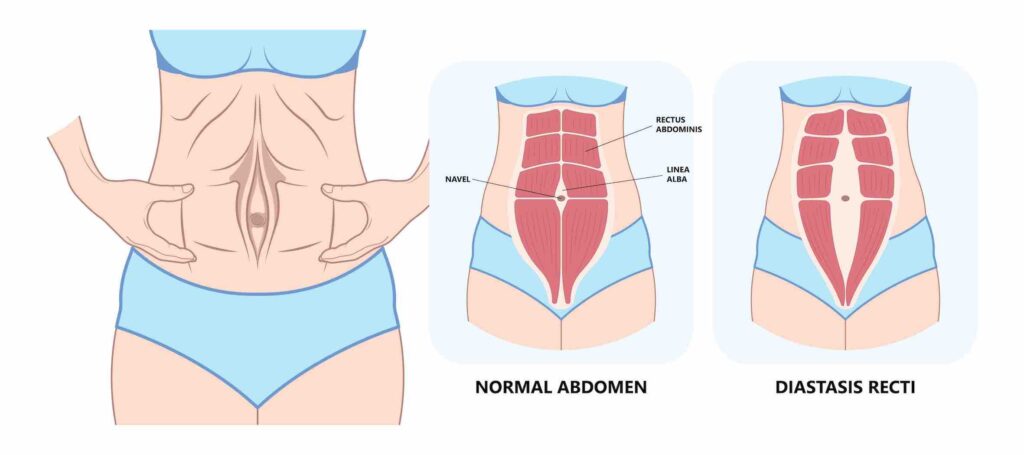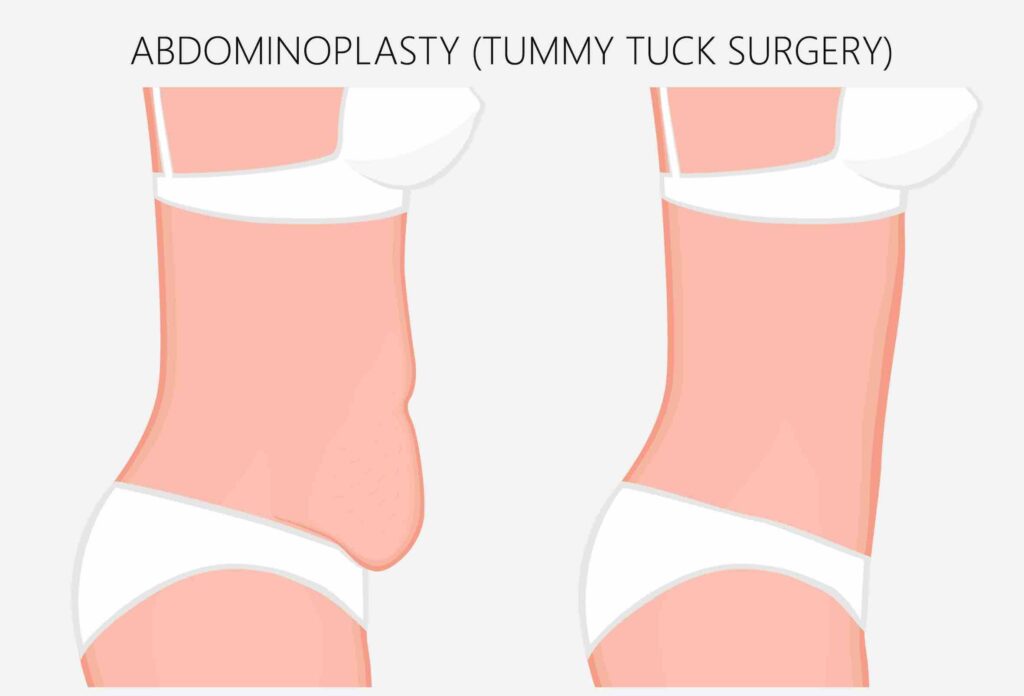It’s no lie that a caesarean section can take an enormous toll on your body. In addition to a C-section scar, one of the most frequent issues women experience is a postpartum belly or a C-section pouch.
A C-section pouch refers to the excess skin and excess fat that accumulates around the abdomen after a C-section procedure. This is also commonly referred to as a pannus stomach, post-pregnancy stomach or apron stomach and can be uncomfortable for many women.
This pouch can occur when the abdominal muscles are stretched beyond their normal capacity during childbirth, leaving them weak and unable to support the body’s structure as effectively. As a result, a pocket of loose tissue and stubborn excess fat can form in the lower abdominal region.
This article explores the causes, symptoms and various treatment options including abdominoplasty (tummy tuck) surgery. An abdominoplasty (tummy tuck) with muscle repair after a c-section can be a comprehensive approach to treating this condition.
What is a C Section Pouch?
An abdominal delivery, better known as a caesarean section, is a surgical procedure in which the baby is delivered through an incision made on your abdomen. To perform this operation, your doctor must cut through multiple layers of nerve endings, muscular tissue and flesh.
This procedure can also cause the muscles to separate and become weak, making it difficult for them to hold everything firmly in place.
The lack of muscle tone can lead to an accumulation of fat around your midsection and a protruding abdomen. This is otherwise known as a C-section shelf. This ‘shelf’ of scar tissue then may cause excess hanging skin, fat and scar tissue.
A C-section stomach is particularly common in women who have had one or multiple C-sections.
Causes of C Section Pouch
The development of an apron stomach is often attributed to several factors, such as weight gain during pregnancy, hormonal changes, and genetics. Causes of a loose stomach with excess skin after pregnancy can include:
Pregnancy
The most common cause after c-section is the increase in intra-abdominal pressure from the baby pushing down on the abdomen during delivery. This excess pressure can stretch the muscles of the abdomen, resulting in the appearance of a stomach bulge.
Weight Gain
Weight gain during pregnancy can also lead to the formation of a C-section pouch. As your baby grows, the extra weight placed on your abdominal muscles can cause them to stretch and become weak. This can lead to an accumulation of excess fat and adipose tissue in the lower abdominal region, resulting in a bulge or pouch.
Hormonal Changes
In addition to this, some women experience hormonal changes during pregnancy. This can cause their body to store more adipose tissue than normal. Furthermore, estrogen is a hormone released during pregnancy that can cause the connective tissues to weaken. This makes it more difficult for the tissues to hold the abdominal muscles together.
Genetics
Genetics also play an important role in the development of an apron belly. Some women are born with weaker abdominals or lack connecting tissue. This can affect the elasticity of the abdominal wall.
These factors all work together to cause the development of a loose stomach after pregnancy. They can increase by any further pregnancies or weight gain.
Symptoms
Pouch After C Section
The primary symptom of a C-section pouch is the appearance of a protruding or bulging stomach in the lower abdominal region.
Abdominal Pain
This can be accompanied by abdominal pain and discomfort when exercising, due to the weakened abdominal muscles being unable to support the body’s structure effectively.
Weak or Separated Core Muscles
Other symptoms may include diastasis recti, which is a separation of the abdominal muscles. This abdominal separation can occur due to the intense pressure on the abdomen during delivery. It also weakens the core muscles which are responsible for supporting your midsection.
Discomfort While Exercising
In addition to this, performing exercises such as planks and sit-ups can be very uncomfortable, as the weakened core muscles are unable to support your body. This causes discomfort and also increases the risk of injury when exercising.
Other Symptoms
The lack of core support may also lead to other issues. This includes lower back pain, pelvic instability, and urinary incontinence. These symptoms can be incredibly difficult to manage throughout motherhood and can have a major impact on comfortability.
This is why it’s important to seek treatment for a C-section pouch as soon as possible to reduce the long-term risks associated with the condition.
C-Section Pouch vs Diastasis Recti

C-section pouch and diastasis recti are both related to changes in the abdominal muscles and tissues, but they have different causes and symptoms.
C-section pouch is a bulge or protrusion that can form in the lower abdomen after a C-section surgery. Diastasis recti is abdominal separation that can occur during pregnancy or childbirth.
C-section pouch is caused by weight gain during pregnancy, hormonal changes, and weakened abdominal muscles. Diastasis recti is caused by the stretching and thinning of the connective tissue that holds the abdominal muscles together.
The symptoms of the C-section pouch are primarily cosmetic, whereas, the symptoms of diastasis recti can include physical discomfort and health problems and are therefore considered medical.
The treatment options for c-section pouch and diastasis recti are also different. A C-section pouch may be treated with exercise, a healthy diet, and cosmetic procedures such as a tummy tuck (Abdominoplasty). While diastasis recti is treated with physical therapy, corrective exercises, and surgery.
Prevention and Treatment of a C-Section Pouch
The best way to prevent and treat a c-section pouch is to maintain a healthy lifestyle. This includes eating a balanced diet, exercising regularly, getting enough sleep, and avoiding activities that may put too much strain on the abdominal muscles.
It’s also important to practice good posture when sitting or standing. This helps support the core muscles and abdominal wall.
Abdominal treatment steps are best done during postpartum recovery to prevent the formation of an apron belly. Always consult with your healthcare provider before beginning any exercise routine or treatment program.
Non-Surgical Treatments
Non-invasive approaches to help manage and treat a c-section pooch may include:
Exercise and Physical Therapy
Exercise can help strengthen the core muscles and promote better posture. Stomach exercises include planks, pelvic floor exercises, and gentle yoga poses such as cat/cow stretches or the downward dog.
Supportive Undergarments
In addition to this, regular use of supportive undergarments can help support the core muscles. A medical-grade abdominal binder may help to reduce the appearance of a C-section pouch.
Diet and Nutrition
A balanced, nutrient-rich diet can also help promote weight loss which may reduce the appearance of a c-section pouch. Eating plenty of fruits and vegetables and avoiding processed foods can help support overall health. It will also help you maintain a healthy weight.
Skin Care
Finally, using a topical cream or lotion that contains vitamin A can help improve skin elasticity. It may also help reduce the appearance of scars. This may help to improve the appearance of a stomach pouch.
Surgical Treatments

If non-surgical interventions are unsuccessful in treating an apron stomach, plastic surgery treatments may be recommended. This may include liposuction to remove excess fat in the area or an Abdominoplasty (tummy tuck) to remove loose skin and tighten underlying muscles.
Liposuction
This is a cosmetic procedure that can remove excess fat from the abdomen. It can help reduce the appearance of a c section pouch however cannot address the underlying problem.
If the underlying muscle separation is severe, an Abdominoplasty (tummy tuck) Gold Coast may be recommended.
Abdominoplasty Tummy Tuck
Abdominoplasty, or tummy tuck surgery, involves removing excess skin and excess fat from the abdomen and repairing any separated abdominal muscles. This is a treatment option for c-section pouch removal as it tightens loose skin and reduces excess fat.
There are risks involved with any surgical procedure. It’s important to discuss all of your options with your healthcare provider before deciding on a treatment plan.
Postpartum Recovery Tips
Postpartum recovery is a lifelong journey. To ensure that you continue to feel healthy and strong post-delivery, it’s important to commit to lifestyle habits such as:
- Regular exercise
- Good nutrition
- Core stability exercises
- Stress management, and
- Self-care.
These will ultimately help you manage the challenges that come with postpartum recovery. This will take time, but it is possible with commitment and patience.
FAQs
How to Reduce Postpartum Loose Stomach Skin?
Abdominoplasty surgery is generally considered a permanent procedure to address the excess skin on the stomach. It may address all aspects involved with post-c-section recovery. This includes excess fat, loose skin and weak and/or separated abdominal muscles.
This procedure should be combined with healthy lifestyle habits such as exercise and good nutrition.
Please note, that all surgery involves risk. Choosing to undergo this procedure should be a well-thought-out decision and considered only when you are finished having children.
When to Start Exercising After a C Section?
Exercising after the c-section should generally be postponed until at least 6 weeks postpartum. This gives the body ample time to heal and recover from the surgery. However, it’s important to note that every woman recovers differently. You should talk to your doctor before beginning any exercise routine.
C-section pooch before and after exercises can improve the core and these exercises target the abdominal area. These may help to strengthen your core, reduce back pain and improve posture. Furthermore, it may help to reduce the c-section pouch.
Can Post Pregnancy Procedures Address a C Section Pouch?
Yes, Post Pregnancy Procedures are an option to address the changes that occur after childbirth such as excess skin or unwanted fat in the abdominal area. Post Pregnancy Procedures surgery is a combination of abdominoplasty surgery and breast surgery.
A qualified plastic surgeon such as Dr Doyle at Gold Coast Plastic Surgery will be able to advise on the best treatment approach for your individual situation.
Final Thoughts
Many women experience a c-section pouch, and there are treatment options available. Always seek advice from your GP or obstetrician before commencing any treatment.
About Dr Mark Doyle FRACS (Plas) – Queensland Plastic Surgeon
Servicing patients in Gold Coast, Brisbane, Sunshine Coast, Cairns and New South Wales NSW – Northern Rivers, Byron Bay, Ballina, Lismore and more.
Dr Mark Doyle is a fully qualified Specialist Plastic Surgeon with over 30 years of experience performing breast, body, face and nose surgery. He has completed all required training and only carries out approved surgical practices. There are NO undertrained doctors or cosmetic doctors acting as surgeons at Gold Coast Plastic Surgery.

